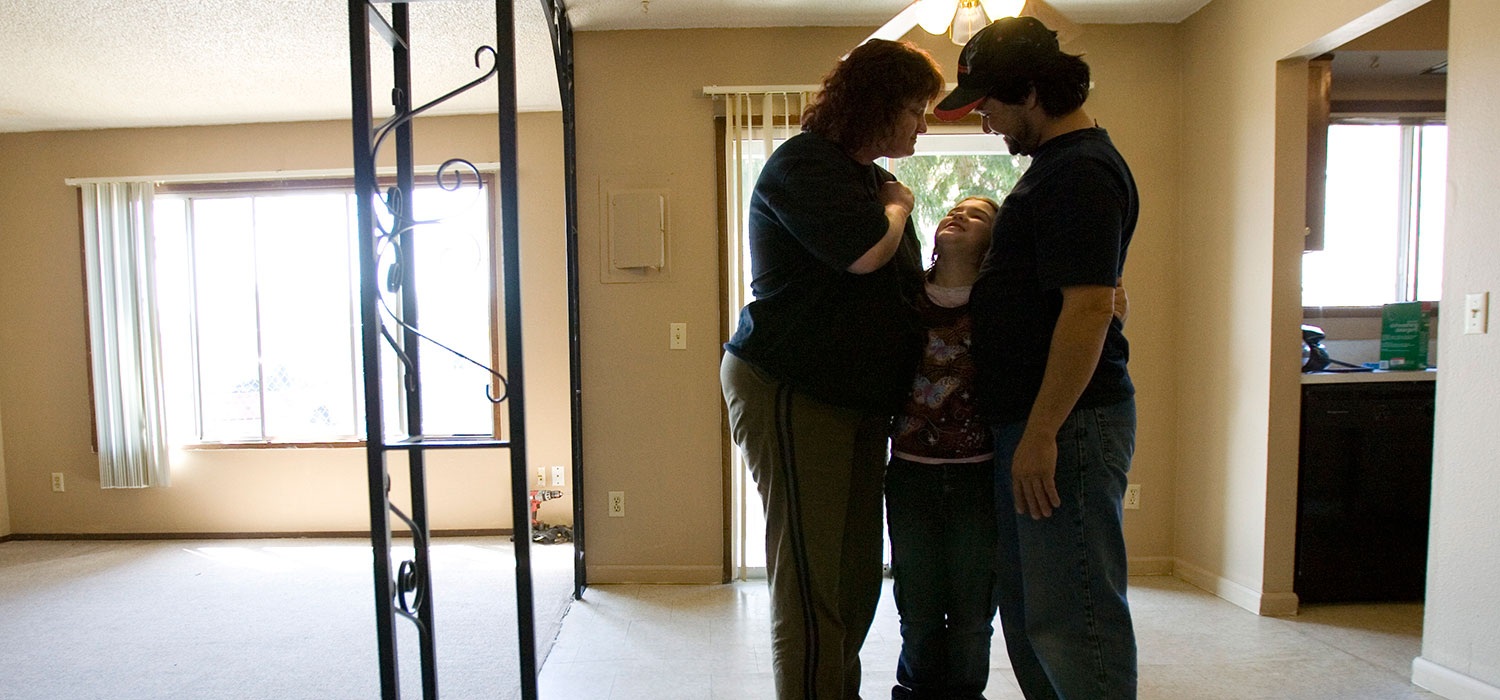
<p>In this April 24, 2009 photo, Joe and Heidi Ledesma hug their 10-year-old daughter, Brehanna, while moving into their new apartment in Portland, OR. The Ledesmas became homeless soon after Joe lost his construction job last December. He recently secured a painting job, and the family has finally moved into their own place after months of surviving in shelters, selling plasma and collecting cans and bottles for money. Photo by Don Ryan/AP.</p>
The fast track to ending family homelessness by 2020 is increasing housing vouchers. It’s. That. Simple.
Family homelessness increased during the recession, but, in recent years, is declining slowly. Hundreds of homeless service providers across the country are trying to end family homelessness with limited tools, and progress is slow due to the nationwide shortage of vouchers. Using housing vouchers would certainly make their job easier, but homeless service providers do not control access to vouchers—public housing authorities do, and the waiting lists are really long.
So what should homeless service providers do while waiting for Congress to fund more vouchers?
We are learning a lot from the Family Options Study that will help improve the programs that together make up the system that serves homeless families: emergency shelter, rapid re-housing, and transitional housing. These are the safety net programs families turn to when they lose their housing, so they don’t have to sleep on the street or in a car.
Lesson #1: Housing First works
Housing First is an approach that aims to help homeless families back into housing as quickly as possible, get them stabilized, and then help them get and stay back on their feet. It counters the guiding principle behind transitional housing—that families need services to become “housing ready.” This study shows that most poor families do not need the supervised residential settings, mandated services, drug tests, and curfews often required by transitional housing to learn how to be independent. Homeless families can move directly from shelter to housing whose rent is subsidized by vouchers (or other mainstream housing assistance programs) and maintain their housing without the help of costly services.
Homelessness should be prevented, rare, and, when it does happen, it should be brief. Let’s help families exit homelessness as fast as possible, instead of keeping them homeless for months in transitional housing while they “learn” how to be housed.
Lesson #2: Transitional housing is largely ineffective and resources should be reallocated
Transitional housing provides families rental assistance and services (usually required), for about 12 months (but up to 24), to help them move toward self-sufficiency. The study found that transitional housing (project-based) improves housing stability (though not a lot compared with usual care—about 18 percent return to shelter), but it does not increase income as intended. The success of vouchers, which do not include ongoing services, in promoting housing stability suggests that any positive outcomes from transitional housing are coming from the rental assistance, not the services.
Transitional housing is costly, about $2,706 per family per month—money that could be used to fund more successful strategies, including rental assistance provided by rapid re-housing. Let’s scrap this model as a primary tool to end homelessness among families. HUD allows for reallocating transitional housing resources toward rental assistance dollars, and has advised communities to think strategically about how to redirect these program resources if they are showing poor outcomes.
Lesson #3: Rapid re-housing needs strengthening
Rapid re-housing is a program that helps families exit the system quickly with the help of a short-term rental assistance (usually about 7 months, but can be used for up to 18 months). Compared with usual care, rapid re-housing helps families exit homelessness faster, is less costly (about $878 monthly vs. $4,819), and helps increase income modestly. Unfortunately, it is not enough for long-term housing stability (about 23 percent return to shelter).
This was a disappointing finding, especially since many communities across the country are implementing the strategy, but does this mean that rapid re-housing is a failure? No. Helping families exit shelter more quickly is important because shelters are not positive—and sometimes are even dangerous—places for families and children; plus, as the study notes, emergency shelter is expensive (about $4,819 monthly), so the cost of not helping families exit shelter is significant. The study also found rapid re-housing led to some modest improvements in adult well-being and food security.
Following the study’s release, HUD has noted its continued support of rapid re-housing, but it clearly needs refining. Some families may need the rental assistance provided by rapid re-housing for a longer period. Providers can extend the time within the current program policies.
Finally, it’s important to note that, at the time of the study, rapid re-housing was a new approach, and was implemented quickly with stimulus funding. Future research that tests different variations in the rapid re-housing model is needed on how to strengthen implementation of this approach.
The bottom line: Rental assistance is more effective than services
The common theme here is, except for a small share of families, ongoing services are not necessary for housing stability. So far, we have very little evidence base to support the argument that homeless services increase incomes or economic stability. Current homeless programs can be shaped to help families exit shelter quickly, provide more rental assistance, and reduce spending on costly services. Rental assistance ends homelessness. That’s where the homeless system and HUD should be spending their homelessness dollars.
Let’s build a future where everyone, everywhere has the opportunity and power to thrive
Urban is more determined than ever to partner with changemakers to unlock opportunities that give people across the country a fair shot at reaching their fullest potential. Invest in Urban to power this type of work.